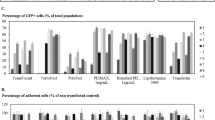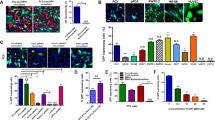Abstract
Retroviruses are currently the most widely used vectors in clinical trials for gene therapy. These vectors are, however, limited by low titres partly due to the restrictive nature of monolayer cell culture. We have developed a stable suspension producer cell line derived from human lymphoblastoid cells (WIL-2) by electroporating these cells with the necessary trans components required for production of defective retrovirus particles which encode a nuclear localising β-galactosidase gene. We show that this anchorage-independent cell line generates viruses at a titre of 7 × 105 iu/ml on NIH3T3 indicator cells which remains constant after at least 2 months in culture. The producer cells can be cultured at a density of 6 × 106 cells/ml with consistent virus titre production. WIL-2 can also be grown as single cells by rotation culture while maintaining virus production. By treating the cells with the transcriptional activator sodium butyrate titres above 1 × 106 i.u./ml are achieved. Concentrating viral supernatants by ultrafiltration can further increase virus titre to 5 × 108 i.u./ml. Even at these high titres no replication-competent virus was detected. Virus titre fell only slightly when cells were placed in serum-free media before harvest. The generation of this novel cell line provides proof-of-principle that large-scale production of retroviral vectors in serum-free growth conditions can be safely generated for use in gene therapy. Gene Therapy (2001) 8, 697–703.
This is a preview of subscription content, access via your institution
Access options
Subscribe to this journal
Receive 12 print issues and online access
$259.00 per year
only $21.58 per issue
Buy this article
- Purchase on Springer Link
- Instant access to full article PDF
Prices may be subject to local taxes which are calculated during checkout






Similar content being viewed by others
References
Andreadis ST et al. Large-scale processing of recombinant retroviruses for gene therapy Biotechnol Prog 1999 15: 1–11
Burns JC et al. Vesicular stomatitis virus G glycoprotein pseudotyped retroviral vectors: concentration to very high titer and efficient gene transfer into mammalian and nonmammalian cells Proc Natl Acad Sci USA 1993 90: 8033–8037
Parente MK, Wolfe JH . Production of increased titer retrovirus vectors from stable producer cell lines by superinfection and concentration Gene Therapy 1996 3: 756–760
Martinez I, Dornburg R . Improved retroviral packaging lines derived from spleen necrosis virus Virology 1995 208: 234–241
Sheay W et al. Downstream insertion of the adenovirus tripartite leader sequence enhances expression in universal eukaryotic vectors Biotechniques 1993 15: 856–862
Pan D, Whitley CB . Closed hollow-fiber bioreactor: a new approach to retroviral vector production J Gene Med 1999 1: 433–440
Le Doux JM, Morgan JR, Snow RG, Yarmush ML . Proteoglycans secreted by packaging cell lines inhibit retrovirus infection J Virol 1996 70: 6468–6473
Le Doux JM, Morgan JR, Yarmush ML . Removal of proteoglycans increases efficiency of retroviral gene transfer Biotechnol Bioeng 1998 58: 23–34
Gerin PA, Searle PF, Al-Rubeai M . Production of retroviral vectors for gene therapy with the human packaging cell line FLYRD18 Biotechnol Prog 1999 15: 941–948
Onodera M et al. Development of improved adenosine deaminase retroviral vectors J Virol 1998 72: 1769–1774
Takeuchi Y et al. Type C retrovirus inactivation by human complement is determined by both the viral genome and the producer cell J Virol 1994 68: 8001–8007
Cosset FL et al. Retroviral retargeting by envelopes expressing an N-terminal binding domain J Virol 1995 69: 6314–6322
Miller AD, Rosman GJ . Improved retroviral vectors for gene transfer and expression Biotechniques 1989 7: 980–982, 984–986, 989–990
Pages JC et al. Activation of Moloney murine leukemia virus LTR enhances the titer of recombinant retrovirus in psi CRIP packaging cells Gene Therapy 1995 2: 547–551
Cosset F et al. High-titre packaging cells producing recombinant retroviruses resistant to human serum J Virol 1995 69: 7430–7436.
Goff S, Traktman P, Baltimore D . Isolation and properties of Moloney murine leukemia virus mutants: use of a rapid assay for release of virion reverse transcriptase J Virol 1981 38: 239–248
Levy JA, Virolainen M, Defendi V . Human lymphoblastoid lines from lymph node and spleen Cancer 1968 22: 517–524
Ferry N et al. Retroviral-mediated gene transfer into hepatocytes in vivo Proc Natl Acad Sci USA 1991 88: 8377–8381
Kozak SL, Kabat D . Ping-pong amplification of a retroviral vector achieves high-level gene expression: human growth hormone production J Virol 1990 64: 3500–3508
Forestell SP, Bohnlein E, Rigg RJ . Retroviral end-point titer is not predictive of gene transfer efficiency: implications for vector production Gene Therapy 1995 2: 723–730
Themis M et al. Enhanced in vitro and in vivo gene delivery using cationic agent complexed retrovirus vectors Gene Therapy 1998 5: 1180–1186
Acknowledgements
This work was funded by The Cystic Fibrosis Trust and the Medical Research Council. We wish to thank C Artlett at the MRC Sussex for providing our laboratory with the WIL-2 cell line and Dr C Porter at the Institute of Cancer Research, London for providing the goat polyclonal anti-RLV gp69/71 antibody. Also we wish to thank Y Takeuchi for providing the viral vectors pCeB, pFBMOSALF and the TELCeB/AF-7 cell line producing the MFGnlslacZ viral vector used in this study. During the preparation of this manuscript we became aware that Y Takeuchi has used the same viral constructs on alternative suspension culture cell lines for the production of amphotropic pseudotyped retroviruses.
Author information
Authors and Affiliations
Rights and permissions
About this article
Cite this article
Chan, L., Coutelle, C. & Themis, M. A novel human suspension culture packaging cell line for production of high–titre retroviral vectors. Gene Ther 8, 697–703 (2001). https://doi.org/10.1038/sj.gt.3301456
Received:
Accepted:
Published:
Issue Date:
DOI: https://doi.org/10.1038/sj.gt.3301456
Keywords
This article is cited by
-
Production of retroviral vectors in continuous high cell density culture
Applied Microbiology and Biotechnology (2023)
-
Development of a laboratory scalable process for enhancing lentivirus production by transient transfection of HEK293 adherent cultures
Gene Therapy (2020)
-
Suspension packaging cell lines for the simplified generation of T-cell receptor encoding retrovirus vector particles
Gene Therapy (2007)
-
Generation of a high-titer packaging cell line for the production of retroviral vectors in suspension and serum-free media
Gene Therapy (2007)



